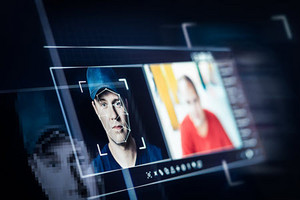Deepfakes
Deepfakes are now prevalent on social media platforms and the Internet. While they can be used legitimately to create entertainment content, they can also be used by scammers to prey on new victims.

Understanding deepfake technology
A deepfake, as the name suggests, uses artificial intelligence to create highly realistic images or sound clips of fake events. Deepfakes can be used to accurately recreate the voices or fabricate highly realistic-looking videos of well-known public figures. Scammers can also use deepfake technology to design fictitious people with virtual lives by setting up fake social media profiles for them. In short, deepfakes can make anyone say anything—sometimes in order to get you to put money into totally fictitious investments or to discredit a well-known public figure.
Red flags
Well-designed deepfakes are difficult to spot. To protect yourself from potential deepfake scams, it’s important to know how to recognize them. Here are some red flags:
- A celebrity or well-known person offers you a high-return, risk-free investment. Scam artists often use fake videos or recordings to make things appear convincing.
- Someone asks you for access to your computer, saying they need access in order to help you. They may be attempting to take control of your computer remotely.
- You feel under pressure to make a quick decision to avoid missing out on a “chance of a lifetime.”
- Someone asks you to make a very small initial deposit (for example, $250) to earn your trust in order to get you to invest even more.
- Communication suddenly stops after you’re allowed to withdraw a portion of your money.
Tips and advice to protect yourself
-
Check the information: Make sure the firm or individual that contacts you is in the Register of firms and individuals authorized to practise and use the contact information in the register rather than the information the firm or individual provides. When in doubt, contact our Information Centre.
-
Check the source: Find out the source of the video. What site or platform is it from? Is it a trusted source? There are sites that specialize in checking viral videos for authenticity. You can search for the video title or details to see whether it has been checked.
-
Look for flaws: Some visual and auditory clues can help you detect deepfakes, such as unnatural blinking of the eyes; short, jerky movements; lip movements and voices that seem out of sync; or tones of voice and facial expressions that don’t match up.
- Take some time to think things through: Don’t give in to pressure to make a quick decision and don’t fall for promises of high returns for no risk.
- Don’t share your personal information: Never give out your personal or financial information without first checking such things as the AMF Register to make sure the person asking for the information is trustworthy. Don’t give anyone remote access to your phone, tablet or computer.
What to do in the event of fraud
Anyone can be a victim of fraud, so don’t beat yourself up. Deepfakes are becoming more sophisticated and increasingly difficult to detect.
-
Refer to the You're a victim of fraud? page to find out what to do, and contact the AMF if the fraud involves purported investments.
-
Break off all communications with the person or persons involved and stop sending money.
